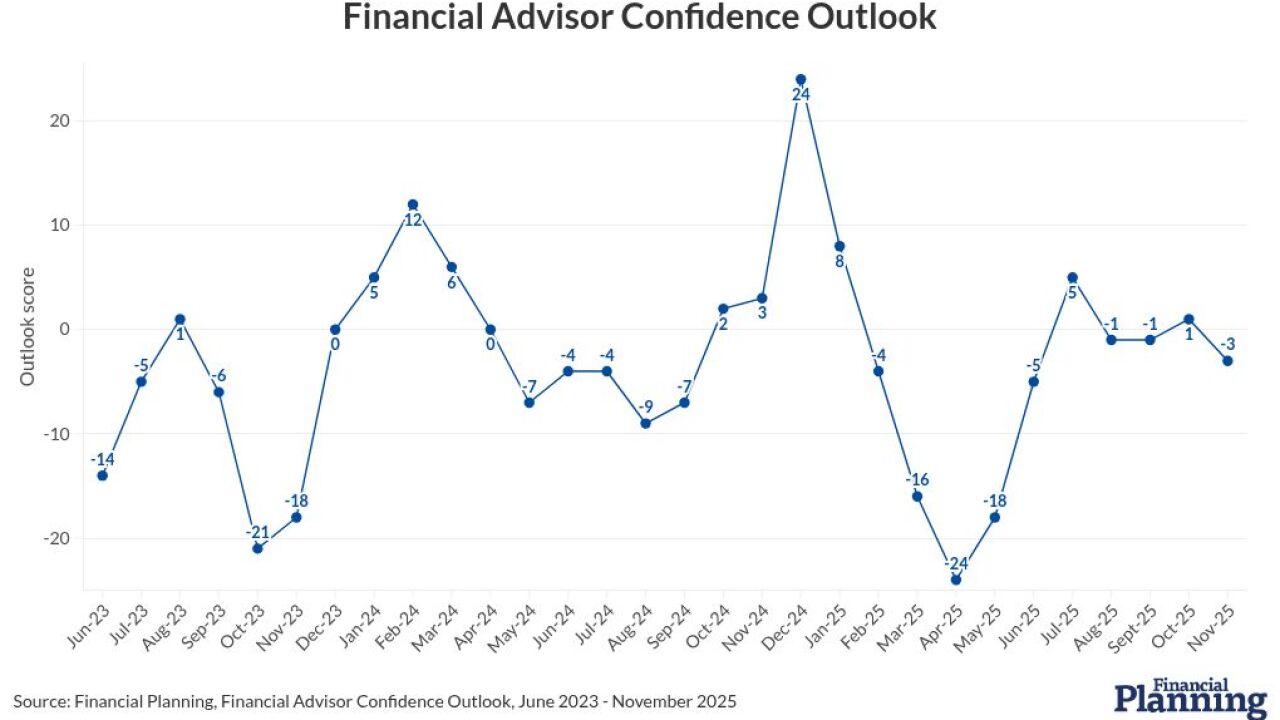Digging into the technological and regulatory challenges that push asset managers to seek out outsourced support, one software firm's research suggests it might be time to consider looking inward instead.
The reason? Data.
While the volume of data generated by firms is increasing exponentially, the need to be able to deliver it accurately and timely for clients has become a competitive factor, according to Simcorp, which surveyed 100 heads of operations in North America.
Being in control of your data could be an edge over a firm that is outsourcing the processing of it, says Marc Mallett, vice president of product at SimCorp North America.
"[Firms] are recognizing the status quo are looking at not only whether outsourcing makes sense, but where can they get the most efficient view of their data in one place," Mallet says. "If they want to achieve the idea of a whole office solution, that's not going to happen with an outsourcing provider. They are going to need to retain a major portion of their data in-house and ensure that they have the timing and accuracy that they need."
The majority of managers quizzed by Simcorp and research firm InvestOps report they are investing in technology with the intent of streamlining operations — 54% said they were automating to remove manual processes, and 77% of respondents said they will allocate up to 20% of their overall revenue to IT spending. But speaking with Money Management Executive, Mallet asks, can firms achieve operational efficiency when theyhave multiple disparate systems and multiple service providers?
An edited version of the conversation follows.
What are some of the biggest outsourcing trends in asset management that you see today?
Mallett: A lot of the current trends we see come back to data accessibility and accuracy. One of the things that jumped out at me in the findings was one of the questions about the top challenges in dealing with outsourcing providers.
Respondents in the survey suggested there is a lack of flexibility in dealing with customized requests, a lack of control and accessibility and certain levels of investment data, and a lack of agility in responding to new initiatives. When I saw all of those findings I found that it was interesting that having a consolidated view of the investment book of records that would address many of these challenges.
When you talk about trends, we are starting to see firms that are looking to insource that investment book of record if one doesn't exist.
It's really taking a number of firms to challenge the status quo. It's not only with outsourcing, but also the best-in-breed nature, in particular in North America, in investment operations operating model. So you have firms not only outsourcing certain functions, but then what with they have internally is running across multiple disparate platforms. And it's really difficult to achieve operational efficiency and ultimately operational alpha when you have multiple disparate systems and multiple service providers.
The CEO of the Consultancy Forward Look has done extensive research into the impact that operations can have on retaining alpha. Inefficient operations can be a drag on alpha up to 241 basis points. Firms, meanwhile, are starting to realize they need more efficient operations. They are recognizing the status quo are looking at not only whether outsourcing makes sense, but where can they get the most efficient view of their data in one place. If they want to achieve the idea of a whole office solution, that's not going to happen with an outsourcing provider. They are going to need to retain a major portion of their data in-house and ensure that they have the timing and accuracy that they need.
The trends that we're seeing is the firms are certainly looking at both and it's really reassessing what it is that they can really achieve with an outsourcing provider. We are finding firms that have outsourced in the past, coming back and realizing that it was not necessarily the nirvana that they thought it would be. I think that's who you are seeing in the results in the polled question specifically in reference to what they are struggling with. These are the exact things that are driving investment managers to reconsider outsourcing if they have already done it and to really question whether or not it's something that they should do on a go-forward basis.
What challenges must managers overcome related to European regulations?
Mallett: When you look at some of the regulations that are coming into play, so much of it is around being able to provide a complete, accurate and transparent view of a book of business.
Ultimately the final report that ends up going to the regulators may end up as something that becomes more efficient, but ensuring that all of data are in the right place, accurate and timely, in our mind and not something that needs to be outsourced - and quite frankly this is not well suited for outsourcing.
You can have complete control and responsibility for that data in house, and we are engaging not only with our clients in Europe, but for things like Mifid II - where we have clients in North America that are certainly headquartered in North America, but are doing business in Europe - are still impacted by those regulations.
We have a regulatory center of excellence that's based in Germany that focuses on all the new regulatory issues that are impacting our clients. We work with them to ensure that they have access to the functionality and information to make those reports. We certainly don't believe that there is any kind of inherent need to outsource those responsibilities.
What do firms need to do to build up their own IT infrastructure?
Mallett: We have clients and other software companies that offer software as a service, but there certainly isn't a significant amount of value for an asset manager in running their own technology infrastructure. Operational outsourcing -- giving control over your book of record and trade processing and all you're reporting to a third party - is very different than asking a partner to be responsible for the technical infrastructure.
When considering what someone should be thinking about doing in order to support this infrastructure - if they're spending 20% of their revenue every year on technology - we would suggest they look at simplifying the application environment. They should have data moving to as few places as possible. If you are able to simplify the technical environment that you're running your business on, and you are able to consolidate data if at all possible in one place, all of the reporting that you are going to need to do becomes far less complicated. It also becomes far less complicated to manage in that environment.
Severs: Let's say you have a manager that trades OTC instruments and has their operations outsourced; in order to do the collateral management process, and then also fulfill all of the various regulatory regimes that are required and reporting related OTC [products], you might have to take information from the front office portfolio management and order management systems, a separate unique collateral management tool and then accounting information from the outsourcer. Then you would have to bring all of that information together and combine one source to link all for that information. Perhaps a data warehouse could be used to extract this information and fill out the report.
To Marc's point, if you can simplify the middle- and back-office into a whole office solution; and you have one single data set from the point of trade all the way through the collateral office and into accounting, and everything is sitting in one instance and not needing to be reconciled between multiple systems, then that information - that one data - can be used to fulfill the regulatory operations.
In an outsourced world, that simply isn't possible because the back- or middle-office accounting is sitting in one location that's being enriched with front-office data for the inside investment manager.
How can firms marry front- and middle-office to a back-office approach?
Mallett: Most firms today have separate systems, processes and services for front office, middle office and back office. What we're suggesting is that if you are looking to manufacture products - if your example is the front-office notes that they want to start trading asset types, or start offering to the market a new investment product, a very common model with disparate processes across the front-, middle- and back-office systems. You are only as good as the worst performing part of that infrastructure.
You have to now either negotiate with internal and external service providers across all the different parts of the investment lifecycle to determine when it is you will be able to introduce this new product. You can't just work with one system and in effect one partner, whether that is internal or external. There's simply an inherent inefficiency in that model and your time to market introduce new product is slowed down by that and whether you can apply the problem of regulatory performing as new regulations are introduced. Again you have to go through multiple different parties in order to determine when you will be able to comply with a particular regulation.
Simplifying that and supporting the whole office will make the introduction of new product more efficient, the ability to respond to regulatory change more efficiently and ultimately deliver what it is that your front office wants.
The study notes client demand will be the biggest driver of change. Can you explain why?
Mallett: If you look at the trends in asset allocation over the last several years, clearly there's a significant uptick in the allocation to alternative investments, to private equities and private debt.
If you bring that back to the typical legacy operating model with an investment manager, it's about having disparate systems for parts not only relating to investment lifestyle, but also different asset classes.
They will have front-offices for equity, for fixed-income, derivatives and potentially on spreadsheets for their alternatives portfolio.
Then as you go further down in the investment lifecycle, they have different systems and processes to support all of these different asset classes. They also have different manufacturing groups. Historically they haven't had a multi-asset class strategy where an investor can request that. They have to put them together themselves.
Certainly they are going to investment managers demanding this type of services with the product that they want. They are looking for more absolute return because they have liabilities that are increasing and that's not correlated to market performance, but to the growth of their liabilities.
There's competition now. Today, asset owners are in effect now competing directly with asset managers.
If you're an asset manager you better get really good really fast at managing multi-asset class portfolios and be able to prove to the asset owner community that you can do it better than they can, more efficiently, or else they are going to do it themselves.
That's where the automation comes in. There are fewer systems able to support the whole office, across a multi-asset class approach, not having to bring in multiple bespoke platforms for your front-office that you would have to learn and deal with.





